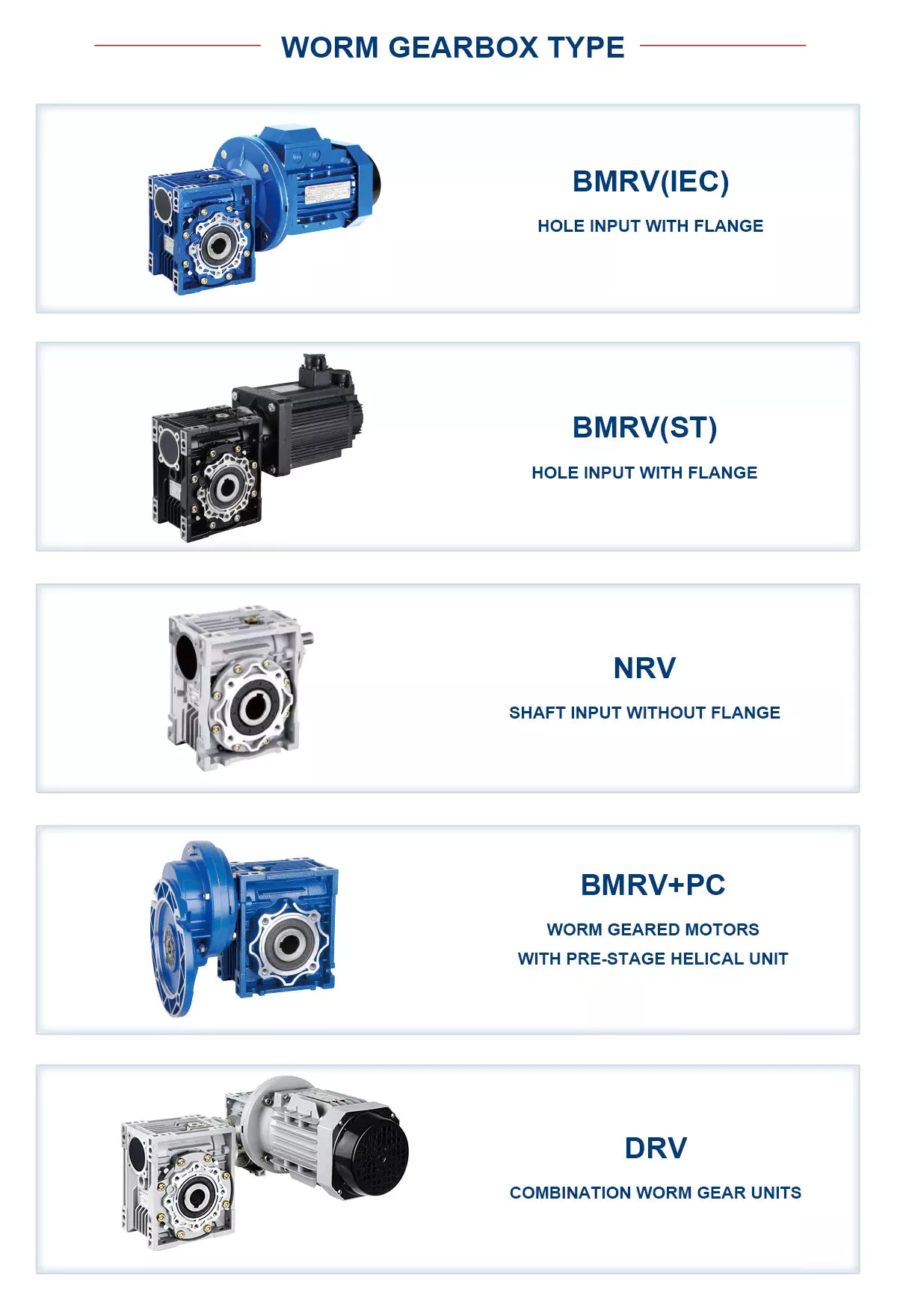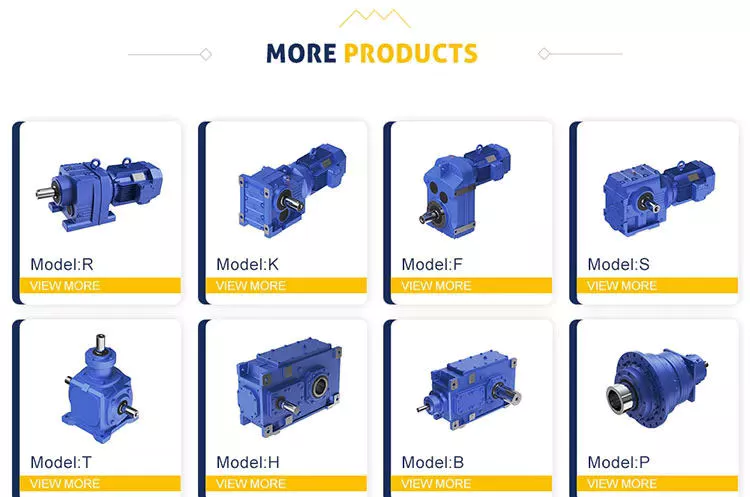Product Description
Gearbox Worm Drive Gear Box Wheel Speed Reducer Jack Worm Planetary Helical Bevel Steering Gear Drive Nmrv Manufacturer Industrial Gearbox Worm Drive
Application of Industrial Gearbox
Industrial gearboxes are used in a wide variety of applications, including:
- Conveyors
- Wind turbines
- Elevators
- Machine tools
- Mining equipment
- Construction equipment
- Agriculture equipment
- Robotics
- Automotive
- Aerospace
Industrial gearboxes are used to transmit power from a motor to a load. They can be used to increase torque, decrease speed, or both. Industrial gearboxes are typically made of steel or cast iron and are designed to withstand high loads and harsh environments.
Here are some of the advantages of using industrial gearboxes:
- Increased torque: Industrial gearboxes can increase the torque output of a motor. This is useful in applications where a large amount of force is required, such as in conveyors and wind turbines.
- Decreased speed: Industrial gearboxes can decrease the speed of a motor. This is useful in applications where a high speed is not required, such as in machine tools and elevators.
- Versatility: Industrial gearboxes are available in a wide variety of sizes and styles. This makes them adaptable to a wide range of applications.
- Durability: Industrial gearboxes are made of strong materials and are designed to withstand high loads and harsh environments.
Overall, industrial gearboxes are a versatile and beneficial component that can be used in a wide variety of applications. They can help to improve efficiency, versatility, and durability.
Here are some additional details about the applications of industrial gearboxes:
- Conveyors: Industrial gearboxes are used in conveyors to transmit power from the motor to the conveyor belt. This allows for the efficient transportation of materials.
- Wind turbines: Industrial gearboxes are used in wind turbines to transmit power from the turbine blades to the generator. This allows for the efficient generation of electricity.
- Elevators: Industrial gearboxes are used in elevators to transmit power from the motor to the elevator car. This allows for the safe and efficient transportation of people and goods.
- Machine tools: Industrial gearboxes are used in machine tools to transmit power from the motor to the cutting tool. This allows for the precise machining of materials.
- Mining equipment: Industrial gearboxes are used in mining equipment to transmit power from the motor to the mining tools. This allows for the efficient extraction of minerals.
- Construction equipment: Industrial gearboxes are used in construction equipment to transmit power from the motor to the construction tools. This allows for the efficient construction of buildings and infrastructure.
- Agriculture equipment: Industrial gearboxes are used in agriculture equipment to transmit power from the motor to the agricultural tools. This allows for the efficient cultivation of crops and livestock.
- Robotics: Industrial gearboxes are used in robotics to transmit power from the motor to the robotic arm. This allows for the precise movement of the robotic arm.
- Automotive: Industrial gearboxes are used in automotive applications to transmit power from the engine to the wheels. This allows for the efficient movement of the vehicle.
- Aerospace: Industrial gearboxes are used in aerospace applications to transmit power from the engine to the aircraft’s control surfaces. This allows for the precise control of the aircraft.
Industrial gearboxes are a critical component in many machines and systems. They allow for the efficient and reliable transmission of power, which is essential for many applications.
/* January 22, 2571 19:08:37 */!function(){function s(e,r){var a,o={};try{e&&e.split(“,”).forEach(function(e,t){e&&(a=e.match(/(.*?):(.*)$/))&&1
| Application: | Motor, Electric Cars, Motorcycle, Machinery, Marine, Agricultural Machinery, Car |
|---|---|
| Function: | Distribution Power, Clutch, Change Drive Torque, Change Drive Direction, Speed Changing, Speed Reduction, Speed Increase |
| Layout: | Coaxial |
| Hardness: | Hardened Tooth Surface |
| Installation: | Horizontal Type |
| Step: | Steel |
| Samples: |
US$ 9999/Piece
1 Piece(Min.Order) | |
|---|

How do gear drives handle heavy loads and high torque?
Gear drives are designed to handle heavy loads and high torque in various applications. Here’s a detailed explanation:
1. Gear Geometry:
– Gear drives utilize specific gear geometries to handle heavy loads and high torque.
– The shape and size of gear teeth, such as involute profiles, are optimized to distribute the load evenly across the gear face.
– Gear teeth are designed with appropriate strength and thickness to withstand the forces and torque applied during operation.
2. Material Selection:
– Gear drives are typically made from high-strength materials, such as hardened steel or alloy steels, to withstand heavy loads and high torque.
– These materials offer excellent mechanical properties, including high tensile strength, hardness, and fatigue resistance.
– The selection of appropriate materials ensures the gear drives can handle the required load and torque without deformation or failure.
3. Gear Size and Ratio:
– Gear drives can handle heavy loads and high torque by optimizing the gear size and gear ratio.
– Increasing the size of the gears, including the diameter and width of the gear teeth, enhances their load-carrying capacity.
– Choosing the appropriate gear ratio allows for torque multiplication, enabling the gear drive to handle higher torque requirements.
4. Lubrication and Cooling:
– Effective lubrication is crucial for gear drives to handle heavy loads and high torque.
– Lubricants reduce friction between gear teeth, minimizing wear and heat generation.
– Proper lubrication also helps dissipate heat, preventing excessive temperature rise that can affect gear performance and integrity.
5. Gear Tooth Profile and Tooth Contact:
– Gear drives employ specific tooth profiles, such as involute or helical gears, to optimize load distribution and tooth contact.
– These profiles ensure that the load is distributed across multiple teeth, reducing stress concentration on individual teeth.
– Additionally, gear drives may incorporate modifications, such as crowning or tip relief, to improve tooth contact and minimize edge loading.
6. Structural Reinforcements:
– In applications with exceptionally heavy loads and high torque, gear drives may incorporate structural reinforcements.
– Reinforcements, such as additional support bearings, rigid housings, or bracing, enhance the overall strength and rigidity of the gear drive system.
– These reinforcements help distribute the load and torque more effectively and prevent excessive deflection or misalignment.
By employing appropriate gear geometry, selecting high-strength materials, optimizing gear size and ratio, ensuring effective lubrication, and incorporating tooth profile enhancements and structural reinforcements, gear drives can handle heavy loads and high torque. These design considerations enable gear drives to reliably transmit power and withstand the demanding operating conditions in various industrial, automotive, and machinery applications.

How are gear drives used in renewable energy applications?
Gear drives play a crucial role in various renewable energy applications. Here’s a detailed explanation:
1. Wind Turbines:
– Gear drives are widely used in wind turbines to convert the low-speed rotation of the turbine blades into high-speed rotation suitable for generating electricity.
– The gear drives amplify the rotational speed, allowing the generator to operate at the required speed to produce electricity efficiently.
2. Solar Tracking Systems:
– In solar tracking systems, gear drives are employed to adjust the position of solar panels or mirrors to maximize the capture of solar energy.
– The gear drives enable precise and controlled movement of the panels or mirrors, aligning them with the sun’s position throughout the day for optimal energy collection.
3. Hydroelectric Power Plants:
– Gear drives are utilized in hydroelectric power plants to convert the slow rotational motion of the turbine into high-speed rotation for power generation.
– The gear drives increase the rotational speed and transmit the power to the generator, which converts the mechanical energy into electrical energy.
4. Tidal and Wave Energy Converters:
– Gear drives are employed in tidal and wave energy converters to increase the rotational speed of the turbine or generator system.
– They help convert the relatively slow and irregular motion of the tides or waves into a higher-speed rotation suitable for electricity generation.
5. Geothermal Power Plants:
– Gear drives are utilized in geothermal power plants to transmit power from the geothermal turbine to the generator for electricity production.
– They enable the conversion of the low-speed, high-torque rotational motion of the turbine into high-speed rotation required by the generator.
6. Biomass Energy Systems:
– Gear drives are used in biomass energy systems to convert the rotational motion of the biomass combustion engine or steam turbine into high-speed rotation for electricity generation.
– The gear drives help optimize the rotational speed and torque characteristics of the system for efficient power production.
Overall, gear drives are essential components in renewable energy applications, enabling the efficient conversion of various natural energy sources into usable electricity. They help amplify rotational speed, adjust positions for optimal energy capture, and transmit power from turbines to generators. By facilitating the effective utilization of renewable energy sources, gear drives contribute to the growth and sustainability of clean and renewable energy generation.

Can gear drives be used for speed reduction?
Yes, gear drives can be used for speed reduction in mechanical systems. Here’s a detailed explanation:
Gear drives are commonly employed to reduce the rotational speed of an input shaft to a lower speed at the output shaft. This speed reduction is achieved by utilizing gears with different numbers of teeth and sizes in a gear train. The gear ratio, defined as the ratio of the number of teeth on the driven gear to the number of teeth on the driving gear, determines the speed reduction or increase.
When a small driving gear (with fewer teeth) meshes with a larger driven gear (with more teeth), the output shaft rotates at a slower speed than the input shaft. This is due to the larger driven gear covering a greater distance per revolution compared to the smaller driving gear. The gear ratio determines the magnitude of the speed reduction.
For example, if the gear ratio is 2:1, the output shaft will rotate at half the speed of the input shaft. Similarly, a gear ratio of 3:1 would result in the output shaft rotating at one-third the speed of the input shaft. By selecting the appropriate gear ratio, gear drives can achieve significant speed reduction according to the specific requirements of the application.
Speed reduction using gear drives offers several advantages:
1. Torque Increase: Speed reduction is accompanied by a proportionate increase in torque at the output shaft. This torque amplification is advantageous for applications that require high torque, such as heavy machinery or lifting equipment.
2. Precision Speed Control: Gear drives provide precise speed control due to the fixed gear ratio. This is particularly useful in applications that demand accurate and consistent speed regulation, such as conveyors, machine tools, and robotics.
3. Compact Design: Gear drives offer a compact solution for speed reduction compared to other methods like belt drives. This is especially beneficial in applications where space is limited, such as in automotive transmissions or compact machinery.
4. Efficient Power Transmission: Gear drives have high mechanical efficiency, resulting in minimal power losses during speed reduction. This efficiency is crucial for energy-efficient operation and reduced operating costs.
It’s important to note that gear drives can also be used for speed increase by utilizing a gear train with a smaller driven gear and a larger driving gear. However, speed reduction is a more common application for gear drives in various industries and mechanical systems.
By selecting the appropriate gear ratio and gear types, gear drives offer a reliable and efficient method for speed reduction in a wide range of applications, enabling precise speed control and torque amplification to meet the specific needs of the system.


editor by Dream 2024-04-24
